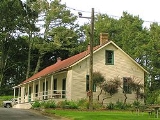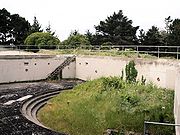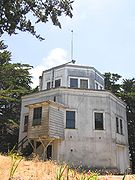
Fort Miley Military Reservation
Encyclopedia
The Fort Miley Military Reservation, in San Francisco, California
sits on Point Lobos (not to be confused with Point Lobos near Carmel-by-the-Sea), one of the outer headlands on the southern side of the Golden Gate
. Much of the site is part of the Golden Gate National Recreation Area
, while the grounds which were converted into a Veterans Hospital are administered by the Veterans Health Administration
of the VA
.
William C. Endicott, heading the Board of Fortifications
, issued a report necessitating the coastal defense
of San Francisco Bay
. By September 1890, Colonel George Mendel, the army engineer officer in charge of defense construction in the San Francisco region, had selected for fortification a 73-acre (29.5 ha) tract of land near Point Lobos which belonged to the City of San Francisco and since 1868 had been the Golden Gate Cemetery. After much intrigue and various maneuverings, the Federal government secured in 1891 condemnation
of 54 acres (21.85 ha) for $75,000.
It was still some years before the army did anything with its new Point Lobos Military Reservation. The Spanish-American War
of 1898 provided the needed stimulus and that year the first two buildings were built there to house a small Signal Corps
detachment whose mission is now long forgotten, though it may have been to provide a warning of the approach of enemy ships during that war.
 The construction of fortifications began soon afterwards. In 1899, a battery
The construction of fortifications began soon afterwards. In 1899, a battery
of two 12-inch rifled guns mounted on Buffington-Crozier disappearing gun
s was put in, which was completed in 1902. A third 12-inch gun was added to what was now Battery James Chester in 1903. Meanwhile, work began on November 27, 1899, on a separate battery for sixteen 12-inch mortar
s. These weapons covered all three of the channels of approach to the Golden Gate—south, main and north.
The reservation was renamed Fort Miley in 1900 after Lieutenant Colonel John D. Miley (who was the father of Maj. Gen. William M. Miley
), who had died in Manila
, Philippine Islands, the year prior.
To man these two batteries the army constructed between them a Parade Ground and a complex of frame buildings built to then-standard plans for barracks
and quarters. The basic complex was built from 1902 to 1906. The horseshoe-shaped Parade Ground was open to the north with a view toward the Golden Gate.
Early in the 1930s the Parade Ground area of Fort Miley, which since World War I had housed generally only caretaker garrisons, was selected as the site of the new Fort Miley Veterans Administration Hospital. The Army retained the batteries, but most of the buildings around the Parade Ground area, with the exception of an ordnance storehouse, were demolished in 1934 to make way for hospital construction.
 By 1937, the army had decided that 12-inch batteries such as Chester should be abandoned when the harbor defenses could again be modernized with a new generation of defenses. However, the Japanese attack on Pearl Harbor
By 1937, the army had decided that 12-inch batteries such as Chester should be abandoned when the harbor defenses could again be modernized with a new generation of defenses. However, the Japanese attack on Pearl Harbor
brought the United States into the Second World War before the new modernization project was completed and Battery Chester's guns continued to play an important role in coastal defense until 1943. The Allied
victories in the Pacific War
that year reduced the danger of an enemy attack on San Francisco to such an extent that the army ordered Battery Chester's guns be salvaged.
Battery 243 (Construction Number) at Fort Miley was completed in 1944, designed for two 6-inch rapid-fire guns protected by steel shields rather than the traditional concrete-and-earth parapet
s. This type of coastal gun was considered to be of value at that late date in the war because of its function to cover the submarine
minefields outside the Golden Gate, making minesweeping by the enemy difficult if not impossible. Indeed, its guns were not mounted until 1948, after most other types of coastal guns had been scrapped. This battery is historically significant because it represents one of the last phases of the traditional concept of coastal defense.
, although no longer on its original site. The remains of several pre-World War I batteries edge the perimeter of the hospital. West Fort Miley offers visitors a grassy picnic area situated among three gun emplacements, including Battery Chester. There is a ropes course on the site operated by the Pacific Leadership Institute, a research institute of the Recreation, Parks, & Tourism Department of the San Francisco State University in the stand of trees east of the Lands End parking lot.
San Francisco, California
San Francisco , officially the City and County of San Francisco, is the financial, cultural, and transportation center of the San Francisco Bay Area, a region of 7.15 million people which includes San Jose and Oakland...
sits on Point Lobos (not to be confused with Point Lobos near Carmel-by-the-Sea), one of the outer headlands on the southern side of the Golden Gate
Golden Gate
The Golden Gate is the North American strait connecting San Francisco Bay to the Pacific Ocean. Since 1937 it has been spanned by the Golden Gate Bridge...
. Much of the site is part of the Golden Gate National Recreation Area
Golden Gate National Recreation Area
The Golden Gate National Recreation Area is a U.S. National Recreation Area administered by the National Park Service that surrounds the San Francisco Bay area. It is one of the most visited units of the National Park system in the United States, with over 13 million visitors a year...
, while the grounds which were converted into a Veterans Hospital are administered by the Veterans Health Administration
Veterans Health Administration
The Veterans Health Administration is the component of the United States Department of Veterans Affairs led by the Under Secretary of Veterans Affairs for Health that implements the medical assistance program of the VA through the administration and operation of numerous VA outpatient clinics,...
of the VA
United States Department of Veterans Affairs
The United States Department of Veterans Affairs is a government-run military veteran benefit system with Cabinet-level status. It is the United States government’s second largest department, after the United States Department of Defense...
.
Beginnings
In 1885, United States Secretary of WarUnited States Secretary of War
The Secretary of War was a member of the United States President's Cabinet, beginning with George Washington's administration. A similar position, called either "Secretary at War" or "Secretary of War," was appointed to serve the Congress of the Confederation under the Articles of Confederation...
William C. Endicott, heading the Board of Fortifications
Endicott Board
Several boards have been appointed by US presidents or Congress to evaluate the US defensive fortifications, primarily coastal defenses near strategically important harbors on the US shores, its territories, and its protectorates.-Endicott Board:...
, issued a report necessitating the coastal defense
Seacoast Defense (US)
Seacoast defense was a major concern for the United States from its independence until World War II. Before airplanes, America's enemies could only reach her from the sea, making coastal forts an economical alternative to standing armies or a large navy. After the 1940s it was recognized that fixed...
of San Francisco Bay
San Francisco Bay
San Francisco Bay is a shallow, productive estuary through which water draining from approximately forty percent of California, flowing in the Sacramento and San Joaquin rivers from the Sierra Nevada mountains, enters the Pacific Ocean...
. By September 1890, Colonel George Mendel, the army engineer officer in charge of defense construction in the San Francisco region, had selected for fortification a 73-acre (29.5 ha) tract of land near Point Lobos which belonged to the City of San Francisco and since 1868 had been the Golden Gate Cemetery. After much intrigue and various maneuverings, the Federal government secured in 1891 condemnation
Eminent domain
Eminent domain , compulsory purchase , resumption/compulsory acquisition , or expropriation is an action of the state to seize a citizen's private property, expropriate property, or seize a citizen's rights in property with due monetary compensation, but without the owner's consent...
of 54 acres (21.85 ha) for $75,000.
It was still some years before the army did anything with its new Point Lobos Military Reservation. The Spanish-American War
Spanish-American War
The Spanish–American War was a conflict in 1898 between Spain and the United States, effectively the result of American intervention in the ongoing Cuban War of Independence...
of 1898 provided the needed stimulus and that year the first two buildings were built there to house a small Signal Corps
United States Army Signal Corps
The United States Army Signal Corps develops, tests, provides, and manages communications and information systems support for the command and control of combined arms forces. It was established in 1860, the brainchild of United States Army Major Albert J. Myer, and has had an important role from...
detachment whose mission is now long forgotten, though it may have been to provide a warning of the approach of enemy ships during that war.

Artillery battery
In military organizations, an artillery battery is a unit of guns, mortars, rockets or missiles so grouped in order to facilitate better battlefield communication and command and control, as well as to provide dispersion for its constituent gunnery crews and their systems...
of two 12-inch rifled guns mounted on Buffington-Crozier disappearing gun
Disappearing gun
A disappearing gun is a type of heavy artillery for which the gun carriage enabled the gun to rotate backwards and down into a pit protected by a wall or a bunker after it was fired...
s was put in, which was completed in 1902. A third 12-inch gun was added to what was now Battery James Chester in 1903. Meanwhile, work began on November 27, 1899, on a separate battery for sixteen 12-inch mortar
Mortar (weapon)
A mortar is an indirect fire weapon that fires explosive projectiles known as bombs at low velocities, short ranges, and high-arcing ballistic trajectories. It is typically muzzle-loading and has a barrel length less than 15 times its caliber....
s. These weapons covered all three of the channels of approach to the Golden Gate—south, main and north.
The reservation was renamed Fort Miley in 1900 after Lieutenant Colonel John D. Miley (who was the father of Maj. Gen. William M. Miley
William M. Miley
Major General William Miles "Bud" Miley was a United States Army major general and a professor of military science.-Early life:...
), who had died in Manila
Manila
Manila is the capital of the Philippines. It is one of the sixteen cities forming Metro Manila.Manila is located on the eastern shores of Manila Bay and is bordered by Navotas and Caloocan to the north, Quezon City to the northeast, San Juan and Mandaluyong to the east, Makati on the southeast,...
, Philippine Islands, the year prior.
To man these two batteries the army constructed between them a Parade Ground and a complex of frame buildings built to then-standard plans for barracks
Barracks
Barracks are specialised buildings for permanent military accommodation; the word may apply to separate housing blocks or to complete complexes. Their main object is to separate soldiers from the civilian population and reinforce discipline, training and esprit de corps. They were sometimes called...
and quarters. The basic complex was built from 1902 to 1906. The horseshoe-shaped Parade Ground was open to the north with a view toward the Golden Gate.
Early in the 1930s the Parade Ground area of Fort Miley, which since World War I had housed generally only caretaker garrisons, was selected as the site of the new Fort Miley Veterans Administration Hospital. The Army retained the batteries, but most of the buildings around the Parade Ground area, with the exception of an ordnance storehouse, were demolished in 1934 to make way for hospital construction.
World War II

Attack on Pearl Harbor
The attack on Pearl Harbor was a surprise military strike conducted by the Imperial Japanese Navy against the United States naval base at Pearl Harbor, Hawaii, on the morning of December 7, 1941...
brought the United States into the Second World War before the new modernization project was completed and Battery Chester's guns continued to play an important role in coastal defense until 1943. The Allied
Allies of World War II
The Allies of World War II were the countries that opposed the Axis powers during the Second World War . Former Axis states contributing to the Allied victory are not considered Allied states...
victories in the Pacific War
Pacific War
The Pacific War, also sometimes called the Asia-Pacific War refers broadly to the parts of World War II that took place in the Pacific Ocean, its islands, and in East Asia, then called the Far East...
that year reduced the danger of an enemy attack on San Francisco to such an extent that the army ordered Battery Chester's guns be salvaged.
Battery 243 (Construction Number) at Fort Miley was completed in 1944, designed for two 6-inch rapid-fire guns protected by steel shields rather than the traditional concrete-and-earth parapet
Parapet
A parapet is a wall-like barrier at the edge of a roof, terrace, balcony or other structure. Where extending above a roof, it may simply be the portion of an exterior wall that continues above the line of the roof surface, or may be a continuation of a vertical feature beneath the roof such as a...
s. This type of coastal gun was considered to be of value at that late date in the war because of its function to cover the submarine
Submarine
A submarine is a watercraft capable of independent operation below the surface of the water. It differs from a submersible, which has more limited underwater capability...
minefields outside the Golden Gate, making minesweeping by the enemy difficult if not impossible. Indeed, its guns were not mounted until 1948, after most other types of coastal guns had been scrapped. This battery is historically significant because it represents one of the last phases of the traditional concept of coastal defense.
Fort Miley today
The ordnance storehouse which survived the 1934 demolition is now a maintenance building for the National Park ServiceNational Park Service
The National Park Service is the U.S. federal agency that manages all national parks, many national monuments, and other conservation and historical properties with various title designations...
, although no longer on its original site. The remains of several pre-World War I batteries edge the perimeter of the hospital. West Fort Miley offers visitors a grassy picnic area situated among three gun emplacements, including Battery Chester. There is a ropes course on the site operated by the Pacific Leadership Institute, a research institute of the Recreation, Parks, & Tourism Department of the San Francisco State University in the stand of trees east of the Lands End parking lot.

